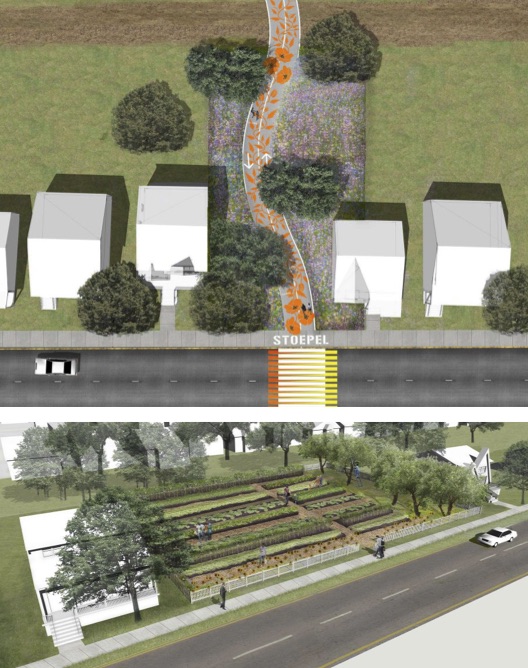Cities like Detroit have become increasingly central to public dialogue about the nature and politics of urban revitalization in the United States. In Detroit—and other urban centers that are home to large populations of non-white residents across the class spectrum—divestment, depopulation, and post-industrialization leave residents vulnerable to the whims of wealthy private investors and government initiatives that benefit the few at the expense of the many.
The term “revitalization” itself is often used euphemistically to obscure insidious, harmful design policies and development practices. For architect and developer Kimberly Dowdell, who was born and raised in Detroit, combating these policies means using real estate development and sustainable design as tools to foster equitable and inclusive cities. She will discuss these strategies in her upcoming lecture, “Diverse City: How Equitable Design and Development Will Shape Urban Futures” at Harvard’s Graduate School of Design.
“Part of my origin story is spending time in downtown Detroit as a little kid and noticing that while it had really good bones and really beautiful old buildings, most of them were either boarded up or largely underutilized,” says Dowdell. “I noticed that the people walking around often looked sad, and I thought to myself—using ‘kid logic’—that the problem was the buildings. I thought that since architects fix buildings, if I fixed the buildings then that would make things better. Of course, I later realized that that’s not entirely how this works.”
Still, the architect’s role in equitable planning and development is crucial, says Dowdell, and the need for more architects of color to contribute to the care of America’s cities is an urgent one. It is this charge that Dowdell takes up in her role as president of the National Organization of Minority Architects (NOMA). There, she has championed a three-pronged plan, “ALL in for NOMA,” to increase representation. (ALL stands for Access, Leadership, and Legacy.) Through the initiative, NOMA provides architecture education to students as young as five through to post-graduate education; leadership training to practitioners in the field; and estate and retirement planning to architects of color who are nearing retirement, with the aim of helping facilitate mentorship for future generations.
Though NOMA’s initiatives place much emphasis on the work of architects and related practitioners, Dowdell makes clear that architects do not work in isolation, and that large-scale change takes a great deal of cross-disciplinary engagement. “I think architects play a major role in improving the way that buildings look and the way that they operate, but obviously a lot of decisions are also made by the developers who take on these projects and by city government, which often has a hand in facilitating that process.”
Her own career trajectory is illustrative of this relationship: Dowdell is a licensed architect, as well as a partner at Century Partners, a Detroit-based development firm whose mission is to facilitate holistic revitalization through sustainable residential housing development. A central strategy in Century Partners’ efforts is harnessing the power of grassroots community outreach and creative placemaking.
A mission as ambitious as Century Partners’ would not be possible without strong municipal support. Dowdell cites smart leadership choices as an essential element in her strategy to foster inclusive development, and she points to Detroit’s director of planning, Maurice Cox, as an example of productive engagement. “I had an opportunity to work with Maurice when I worked in city government, and what was great about that was that I actually got to see him say to developers, ‘You can’t design this here.’ He would directly challenge the architects during meetings, and he would sometimes sketch over existing plans and say, ‘This is a better way to engage the streets,’ or, ‘This is a better way to activate this corner.’ I think that’s really powerful.”
Perhaps most crucially though, in any locale, is real buy-in from city residents. Much of the mainstream narrative surrounding Detroit’s recent “comeback” has emphasized the arrival of young, white transplants and changes to the downtown corridor. It is a narrative that skews the perception of the city’s other neighborhoods and contributes to a real suspicion on the part of black residents who have been affected by displacement under the guise of redevelopment.

The Fitzgerald Revitalization Project is a model to which Dowdell turns when discussing fresh approaches to urban planning that do not neglect residents’ voices. Located within the Fitzgerald neighborhood in northwest Detroit, the project comprises a quarter-square-mile area that was chosen for its location between two anchor institutions, University of Detroit Mercy and Marygrove College, and because it is adjacent to some of Detroit’s more economically resilient neighborhoods. The basis of the project is the implementation of a transformation plan that includes the City of Detroit’s Planning and Development Department, the immediate community, and private philanthropic support, the latter of which Dowdell says is necessary in order to close capital gaps.
“Tri-sector collaboration is really important to success, particularly in a city like Detroit. The economics of certain deals don’t make sense without philanthropic input.” The Fitzgerald Revitalization Project has a three-pronged strategy that addresses public space, housing rehabilitation, and an innovative landscape plan that includes a central park and a greenway. The project began with a neighborhood framework plan created by the city-hired landscape architecture firm Spackman Mossop Michaels, which was later modified based on extensive, ongoing conversations with Fitzgerald residents.
Through their nonprofit arm, Century Forward, Dowdell and her team at Century Partners anticipate the future needs of neighborhood residents, and offer resources beyond the scope of real estate. These efforts might include, for example, providing neighborhood-wide internet access or financial literacy classes. “What I’d like to share with people is the notion that neighborhood revitalization is a very important thing to do, but you have to do it in a way that’s comprehensive because otherwise you are putting a band-aid on a problem that runs much deeper.”
Keep reading about Kimberly Dowdell’s upcoming lecture at Harvard’s Graduate School of Design, presented by the Joint Center for Housing Studies.
